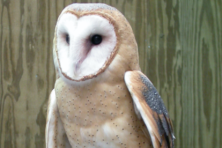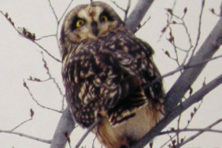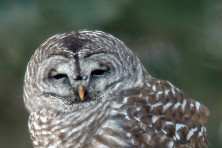Door To Nature: Owls in Winter
- Share
- Tweet
- Pin
- Share

The annual Christmas bird counts (CBC) are happening in Door County this weekend and it made me think about the owls we’ve seen or heard during these surveys over the last quarter century. The Sturgeon Bay and Brussels circles have recorded seven species since these counts began in 1996.
The most common is, of course, the great horned owl. It is by far the most widespread breeding owl in our country, and lives in Door County all year – there’s no need to migrate because it can find food to sustain itself throughout all seasons.
The CBC has been an annual event since the year 1900. They are done all over North America and help scientists learn how bird populations are fluctuating from year to year. Each is conducted inside a 15-mile diameter circle, which is the same area surveyed every year.
I organize these two counts by asking certain birding friends to drive and hike the countryside fields and wood and count the numbers of each species they see or hear. A map is made of the circle and there are designated areas assigned to each field party so that observations are not overlapping.
Then I contact other friends who do counts at their feeders. One of the first years I worked in a dental office in Sister Bay I asked a patient if she would like to participate in this count for the Ephraim circle, which was organized by us at The Ridges Sanctuary.
I explained to her that she should write the name of each species of bird she sees coming to her feeder and note just the greatest number of each kind seen at one time. When I called her to get the results the next day, I realized that I didn’t explain the process very well. She told me that there were 129 chickadees. She counted every time one came to the feeder instead of just the greatest number seen in one viewing. I wrote down 10 and thanked her.
We are fortunate in the two counts that I organize that two brothers come all the way from Evanston, Illinois and Minneapolis, Minnesota to do both counts each year. They work hard at trying to find as many birds as possible within their zone. They go out before dawn to listen for owls, playing recordings to encourage responses.
The great horned and barred, both very large owls, are the most common in these surveys. Barred owls seem to prefer low wet areas, at least during the breeding season. However, in a tough winter with lots of cold and snow they will venture further to seek food. I remember seeing one near our garage one snowy winter. Roy thought it was attracted to the bird feeders with voles or mice looking for dropped food during the night. Great horned owls tend to hunt through the night until dawn, and will take squirrels or rabbits as well as mice and smaller animals.
We learned that the smaller owls, like eastern screech and northern saw-whet, are not very vocal. They can be caught and consumed by great horned owls! Screech owls are more common in the southern half of the state, and saw-whets nest more in the northern part of Wisconsin.
A colony of short-eared owls was present in an area south of Brussels in January of 1995. We counted 10 of them in the 1996 CBC and just two the following year. These owls will live in an area of fallow fields during mild winters and feast on meadow voles and mice, then move on when their food source is depleted.
Long-eared owls can nest in Door County and one was found in December of 2010 east of Sturgeon Bay. We think another nest was in a conifer plantation south of Fish Creek about 15 years ago. They are very rare in our area.
Snowy owls sometimes move into the state when their food supply is low in the high Arctic, where they breed. Often the first snowy owls seen are youngsters that hatched the previous summer and may be starving. I just learned that very few have been seen in the state this fall.
Their primary food in the far north is the brown lemming, a type of rodent. It seems that snowy owls know when the lemming population is extremely low and won’t even nest that year. In good lemming population years, snowy owls will catch and kill these small creatures, often piling them up around their nests.
Two other owl species that have been seen in Door County, but not during a CBC period, are the great gray and the northern hawk owl. There was a major invasion of great gray owls into Wisconsin in 1997. Roy photographed one in Door County in March of that year.
We are very thankful for the people who help with the annual CBC. All this volunteer work adds to the ornithological database to help scientists and environmental advocates working to maintain healthy bird populations.




